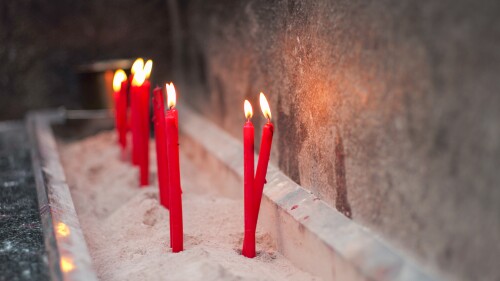A December 2016 bombing inside St. Mark’s Coptic Cathedral in Cairo killed 25 and injured 49, mostly women and children. |
The United Nations recently named March 15 as “international day to combat Islamophobia.” That date was chosen because it witnessed one of the worst terror attacks on Muslims: on March 15, 2019, an armed Australian, Brenton Tarrant, entered two mosques in New Zealand and opened fire on unarmed and helpless Muslim worshippers; 51 were killed and 40 wounded.
Not only has this incident been widely condemned throughout the West — and rightfully so. It has also caused the UN to single out Islam as needing special protection.
This response, however, raises a critically important question: if one non-Muslim attack on a mosque is enough for the UN to institutionalize a special day for Islam, what about the countless, often worse, Muslim attacks on non-Muslim places of worship? Why have they not elicited a similar response from the UN?
Consider some of the fatal Muslim attacks on Christian churches — many, to underscore the religious animosity, occurring just on Easter or Christmas — in recent years:
- Sri Lanka (Apr. 21, 2019): Easter Sunday, Muslim terrorists bombed three churches and three hotels; 359 people were killed and more than 500 wounded.
- Nigeria (Apr. 20, 2014): Easter Sunday, Islamic terrorists torched a packed church; 150 were killed.
- Pakistan (Mar. 27, 2016): After Easter Sunday church services, Islamic terrorists bombed a park where Christians had congregated; more than 70 Christians — mostly women and children — were killed. “There was human flesh on the walls of our house,” a witness recalled.
- Iraq (Oct. 31, 2011): Islamic terrorists stormed a church in Baghdad during worship and opened fire indiscriminately before detonating their suicide vests. Nearly 60 Christians — including women, children, and babies — were killed (graphic pictures of aftermath here).
- Nigeria (Apr. 8, 2012): Easter Sunday, explosives planted by Muslims detonated near two packed churches; more than 50 were killed, and unknown numbers wounded.
- Egypt (Apr. 9, 2017): Palm Sunday, Muslims bombed two packed churches; at least 45 were killed, more than 100 wounded.
- Nigeria (Dec. 25, 2011): During Christmas Day services, Muslim terrorists shot up and bombed three churches; 37 were killed and nearly 57 wounded.
- Egypt (Dec. 11, 2016): An Islamic suicide bombing of two churches left 29 people killed and 47 wounded (graphic images of aftermath here).
- Indonesia (May 13, 2018): Muslims bombed three churches; 13 were killed and dozens wounded.
- Egypt (Jan. 1, 2011): Muslim terrorists bombed a church in Alexandria during New Year’s Eve mass; at least 21 Christians were killed. According to eyewitnesses, “body parts were strewn all over the street outside” and “were brought inside the church after some Muslims started stepping on them and shouting Jihadi chants,” such as “Allahu Akbar!”
- Philippines (Jan. 27, 2019): Muslim terrorists bombed a cathedral; at least 20 were killed, and more than 100 wounded.
- Indonesia (Dec. 24, 2000): During Christmas Eve services, Muslim terrorists bombed several churches; 18 were killed and over 100 wounded.
- Pakistan (Mar. 15, 2015): Muslim suicide bombers killed at least 14 Christians in attacks on two churches.
- Germany (Dec. 19, 2016): Near the Kaiser Wilhelm Memorial Church in Berlin, a Muslim man drove a truck into a Christmas market; 13 were killed and 55 wounded.
- Egypt (Dec. 29, 2017): Muslim gunmen shot up a church in Cairo; nine were killed.
- Egypt (Jan. 6, 2010): After Christmas Eve mass (according to the Orthodox calendar), Muslims shot six Christians dead as they exited their church.
- Russia (Feb. 18, 2018): A Muslim man carrying a knife and a double-barreled shotgun entered a church and opened fire; five people — all women — were killed, and at least five wounded.
- France (July 26, 2016): Muslims entered a church and slit the throat of the officiating priest, 84-year-old Fr. Jacques Hamel, and took four nuns hostage until French authorities shot the terrorists dead.
The above list, it should be noted, is hardly comprehensive; there have been many similar attacks on churches — in Egypt alone, here, here, here, here, here, and here. But because there were no or only few fatalities, they received little, if any, coverage in the Western press.
This dismissal is especially true for those remote and, in the views of Western media, unimportant regions such as Nigeria.
This dismissal is especially true for those remote — and, apparently, in the views of Western media — “unimportant” regions, such as Nigeria, where Christians are being purged hourly in a Muslim-produced genocide. Thus, after noting that Muslims have eliminated 60,000 Christians between just 2009 and 2021, an August 2021 report states that, during that same time frame, Muslims also destroyed or torched 17,500 churches and 2,000 Christian schools. How many undocumented souls perished in those largely unreported terror attacks?
The list above of fatal Muslim attacks on churches does not include any of the many that were botched, for example, a March 28, 2021 attack on a church during Palm Sunday service, where only the suicide bombers — a Muslim man and his pregnant wife — died.
In these fatal church attacks alone, Muslims have massacred hundreds of Christians, not even including the thousands of Christians and other Western people massacred in non-church attacks, including 9/11, London’s 7/7/2005 transit system attacks, Paris’s Charlie Hebdo and Bataclan Theater attack, Barcelona’s Las Ramblas attack, Nice’s July 14 attack, Toulouse’s Jewish school attack, Berlin’s Winter Market and Copenhagen’s terror attacks, to name just a few.
Therefore, the original question: If one non-Muslim attack on a mosque, which claimed 51 Muslim lives, was enough for the UN to establish an “international day to combat Islamophobia,” why have so many Muslim attacks on churches, which have claimed thousands of Christian lives, not been enough for the UN to establish an “international day to combat Christianophobia”?
Put another way, why is one immensely reprehensible but lone incident of a Western man killing 51 Muslims of far greater importance to the UN than the countless instances of Muslims killing untold numbers of Christians?
No doubt the UN would claim that church attacks do not reveal a pattern as does “Islamophobia.”
If ever cornered and forced to explain this discrepancy, no doubt the UN would say that, unfortunate as all of those church and other attacks might be, they do not reveal a pattern, the way “Islamophobia” does; that church attacks are all byproducts of terrorism (which reportedly is in no way connected to Islam) fueled by economics, territorial disputes and inequality, in a word, “grievances.” Fix those temporal problems and attacks on churches will cease.
In reality, the exact opposite appears to be true: whereas the New Zealand mosque attack was indeed an aberration — evidenced by its singularity — Muslim attacks on churches are extremely common, not only now but throughout history. In Turkey, for example, one can see what became of the great Christian Byzantine Empire after it was first invaded by Arabs in the seventh century, to when Constantinople fell to Sultan Mehmed II in 1453, and on to the early 20th century genocide of Armenians, Assyrians and Pontic Greeks.
As can be seen here, seldom does a month pass in the Muslim world today, and increasingly in the West, without several assaults on, or harassments of, churches taking place. While some of these, fortunately, may not have been fatal, they all underscore Islam’s indisposition to churches, and, it would seem, to any religious structure or symbol that is not part of Islam.
The only thing shared by those who attack churches and murder Christians is their religion.
Revealingly, those who terrorize churches often share little with one another: they come from widely different nations (Nigeria, Iraq, Philippines, etc.), are of different races, speak different languages, and live under different socio-economic conditions. The only thing they do share—the one thing that, it seems, leads them to assault churches and murder Christians — appears to be their religion.
In other words, Muslim attacks on churches seem to have an ideological source, are systemic, and therefore an actual, ongoing problem that the international community needs to highlight and ameliorate.
Yet the UN would have us ignore and brush aside all these ongoing massacres of Christian church worshippers as unfortunate byproducts of misplaced “Muslim grievances” — and instead fixate on one solitary, if admittedly horrendous, incident.
For the UN, evidently, one incident constitutes a “pattern” — one in dire need of recognition and response. The response is to silence, ignore or attack all those who expose the heavily documented real pattern of abuse and violence against non-Muslims — which, make no mistake, is precisely what “combatting Islamophobia” is all about.
Raymond Ibrahim is the Judith Friedman Rosen Fellow at the Middle East Forum.








